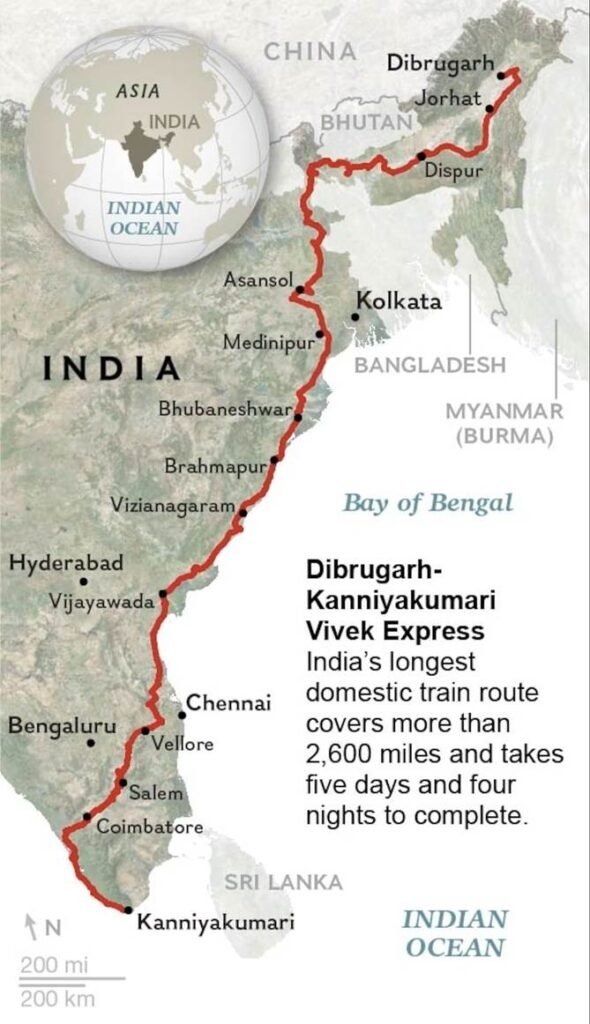Railways are more than just a means of transportation—they are the lifelines of progress, knitting together people, communities, and nations. Since the early 19th century, when steam-powered locomotives first began to roll across continents, railways have revolutionized the way humans connect, trade, and share culture. The blog explores about world’s largest train route.
1. Trans‑Siberian Railway (Russia) — Moscow to Vladivostok
- Distance: 9,289 km (5,772 miles)
- Duration: 6–7 days
- Route Highlights: Crosses eight time zones, passes Lake Baikal, Ural Mountains, Siberian taiga; connects Europe and Asia
- Why it’s legendary: Considered the longest continuous passenger rail route in the world

2. Beijing – Moscow Line (via Mongolia or Manchuria)
- Distance: 7,800–9,000 km depending on route
- Duration: 6 days, five nights
- Passes through: China, Mongolia, Kazakhstan, Russia; includes Gobi Desert, Great Wall, Altai Mountains
3. Shanghai – Lhasa Express (Z164, China)
- Distance: 4,373 km
- Duration: 54 hours (2 days 6 hours)
- Scenery: From lowland plains to high‑altitude Tibetan Plateau, Qinghai Lake, Tanggula Pass (>5,000 m); onboard oxygen supplies available at altitude
4. The Canadian (Canada) — Toronto to Vancouver
- Distance: 4,446 km
- Duration: ~3 days 12 hours (four nights onboard)
- Experience: Epic views of prairies, Rockies, forests; options from economy to luxurious Prestige cabins
5. Indian Pacific (Australia) — Sydney to Perth
- Distance: 4,352 km
- Duration: ~3–4 days (70–75 hours)
- Unique Feature: Includes the world’s longest straight stretch of track (478 km) across the Nullarbor Plain
6. Vivek Express (India) — Dibrugarh to Kanyakumari
- Distance: 4,273 km
- Duration: 80–83 hours (~3–4 days), ~55 stops through 9 states
- Cultural Note: India’s longest train route; spans varied climate zones, languages, and demographics

Comparison Table: At-a-Glance
| Route | Distance (km) | Duration | Regions Covered |
| Trans‑Siberian | 9,289 | 6–7 days | Russia, Lake Baikal, Ural Range |
| Beijing–Moscow | 8,000+ | 6 days | China, Mongolia, Kazakhstan |
| Shanghai–Lhasa (Z164) | 4,373 | 2.5 days | China & Tibetan Plateau |
| The Canadian (CAN) | 4,446 | 3.5 days | Canada |
| Indian Pacific (AU) | 4,352 | 3–4 days | Australia |
| Vivek Express (IN) | 4,273 | 3–4 days | India |
Why These Journeys Matter
- Epic scale: They offer unparalleled access to remote landscapes, cultural immersion, and continental crossing.
- Engineering marvels: From Lake Baikal bridges to Tibetan Pass ventilation systems, Nullarbor’s flat tracks and India diverge region.
- Tourist and heritage value: Famous routes like the Trans‑Siberian or Indian Pacific are global travel icons; others like Vivek Express are deeply symbolic to their nations.
Conclusion
The Trans‑Siberian Railway remains the world’s longest uninterrupted passenger rail route, weaving through rugged terrain across Russia over nearly 9,300 km and eight time zones. Other legendary voyages—the Canadian’s cross‑Canada passage, the Tibetan high‑altitude express, Australia’s iconic coast‑to‑coast run and Dibrugarh-Kanyakumari rail route are thrilling contenders in the “longest journeys” category.
References
- Top global routes and rankings (adda247, Aanavandi, The World Bucket List, Isolated Traveller)
- Shanghai–Lhasa specifics (Aanavandi)
- Canadian and Indian Pacific details (Aanavandi, The World Bucket List, Wikipedia, Isolated Traveller)
- Vivek Express and India coverage (adda247)
- Mythical 13-country route analysis (The Times of India, outlooktraveller.com, The Sun)
- https://commons.wikimedia.org/w/index.php?search=train+pic+for+blog&title=Special%3AMediaSearch&type=image

Leave a Reply